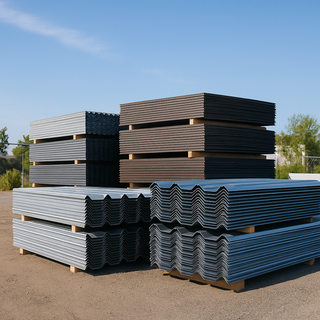When you choose a metal roof, you’re not just picking a product—you’re participating in a sustainable, long-term cycle that begins before the roof is ever installed and continues long after it reaches the end of its service life. Unlike traditional roofing materials that often end up in landfills, metal roofing has a remarkably eco-conscious lifecycle, making it one of the most responsible choices a homeowner or builder can make.
This in-depth guide explores the full lifecycle of a metal roof—from raw material extraction and manufacturing to installation, performance, and eventual recycling—demonstrating how metal roofing blends strength, efficiency, and sustainability every step of the way.
1. Raw Material Sourcing: The Start of a Sustainable Journey
Most metal roofs are made from highly recyclable base materials, including:
-
Galvanized steel
-
Galvalume-coated steel
-
Aluminum
-
Copper
-
Zinc alloys
High Recycled Content
Modern metal roofing coils often contain 25% to 95% recycled content, with aluminum and steel leading the way. These materials are sourced from industrial scrap, post-consumer goods (like recycled cans and automobiles), and factory offcuts.
Fun Fact: Many metal roofs are made from the same materials that go into vehicles, appliances, and beverage containers.
2. Manufacturing and Coil Coating
Coil Production and Processing
Large rolls of steel or aluminum (called coils) are processed in a facility where they are:
-
Leveled and tensioned to remove stress
-
Treated with rust-resistant coatings (like zinc or Galvalume)
-
Painted or finished with high-performance coatings (PVDF or SMP)
Eco-Friendly Coatings
High-end coatings like Kynar 500® not only provide UV and corrosion protection but are also:
-
Low-VOC
-
Energy Star compliant
-
Reflective for cool roof performance
Efficient Manufacturing
-
Minimal waste is generated during coil production.
-
Scraps are reused in the same facility or sent to nearby recyclers.
-
Many manufacturers use solar power or energy-efficient systems during fabrication.
3. Panel Forming and Delivery
After coil coating, metal is:
-
Formed into panels (standing seam, corrugated, metal shingles) using roll-forming machines.
-
Cut to custom lengths to reduce waste and match exact roof specs.
Panels are then bundled and delivered directly to roofing contractors or job sites. Some fabricators even form panels on-site, further reducing shipping emissions and packaging waste.
4. Installation and On-Site Practices
During installation:
-
Minimal material waste is generated compared to asphalt shingles.
-
Panels can be trimmed and reused for flashing or valleys.
-
Protective film is often biodegradable or recyclable.
Best practices like mechanical seaming, concealed fasteners, and airtight underlayments help ensure a weather-tight seal that minimizes maintenance and extends roof life.
5. In-Service Life: Decades of High Performance
A properly installed metal roof can last 40 to 70+ years—double or triple the life of traditional roofing materials.
Benefits During Service Life:
-
Energy Efficiency: Reflective coatings reduce heat gain by up to 40%, lowering HVAC costs.
-
Low Maintenance: No cracking, curling, or loss of granules like asphalt.
-
Durability: Resistant to fire, pests, mold, wind, and hail.
This long lifespan reduces the need for replacement materials, minimizing environmental impact over time.
6. End-of-Life Recycling: Zero Waste Potential
When a metal roof finally reaches the end of its service life:
-
100% of the panels can be recycled.
-
Most roofing contractors sort and transport panels to metal recycling centers.
-
Metal doesn’t degrade through recycling—it can be repurposed indefinitely.
This contrasts sharply with asphalt shingles, which are difficult to recycle and often go to landfills—contributing 11 million tons of waste annually in the U.S. alone.
7. Comparing the Lifecycle of Metal to Other Roofing Materials
| Feature | Metal Roof | Asphalt Shingles | Clay Tile / Slate |
|---|---|---|---|
| Lifespan | 40–70+ years | 15–30 years | 30–100+ years |
| Recyclability | 100% recyclable | Rarely recycled | Sometimes reused |
| Recycled Content | Up to 95% | Minimal | Low–Moderate |
| Waste Generated | Very Low | High | Moderate |
| Embodied Energy | Medium (one-time) | High (frequent replacement) | High |
8. Certifications and Green Building Benefits
Installing a metal roof can contribute to green certifications such as:
-
LEED (Leadership in Energy and Environmental Design)
-
Energy Star
-
Cool Roof Rating Council (CRRC) compliance
Some states offer tax incentives for cool roofs or energy-efficient materials, especially when paired with solar panels or rainwater catchment systems.
9. Enhancing Lifecycle Performance With Smart Choices
To get the most sustainable value out of your metal roof:
-
Choose reputable suppliers with documented recycled content.
-
Opt for cool roof finishes to reduce cooling loads.
-
Use non-toxic underlayments and mechanical attachment methods that don’t compromise recyclability.
-
Pair your roof with solar panel systems or rain harvesting systems for a closed-loop home energy solution.
Conclusion: Long Life, Low Waste, Lasting Value
The lifecycle of a metal roof is a blueprint for sustainable construction. From recycled beginnings and low-waste manufacturing to decades of efficient performance and a 100% recyclable end, metal roofing outperforms almost every other roofing material—not just in strength and style, but in environmental responsibility.
Choosing a metal roof means choosing a system that protects your home, your energy bills, and the planet—for generations.






